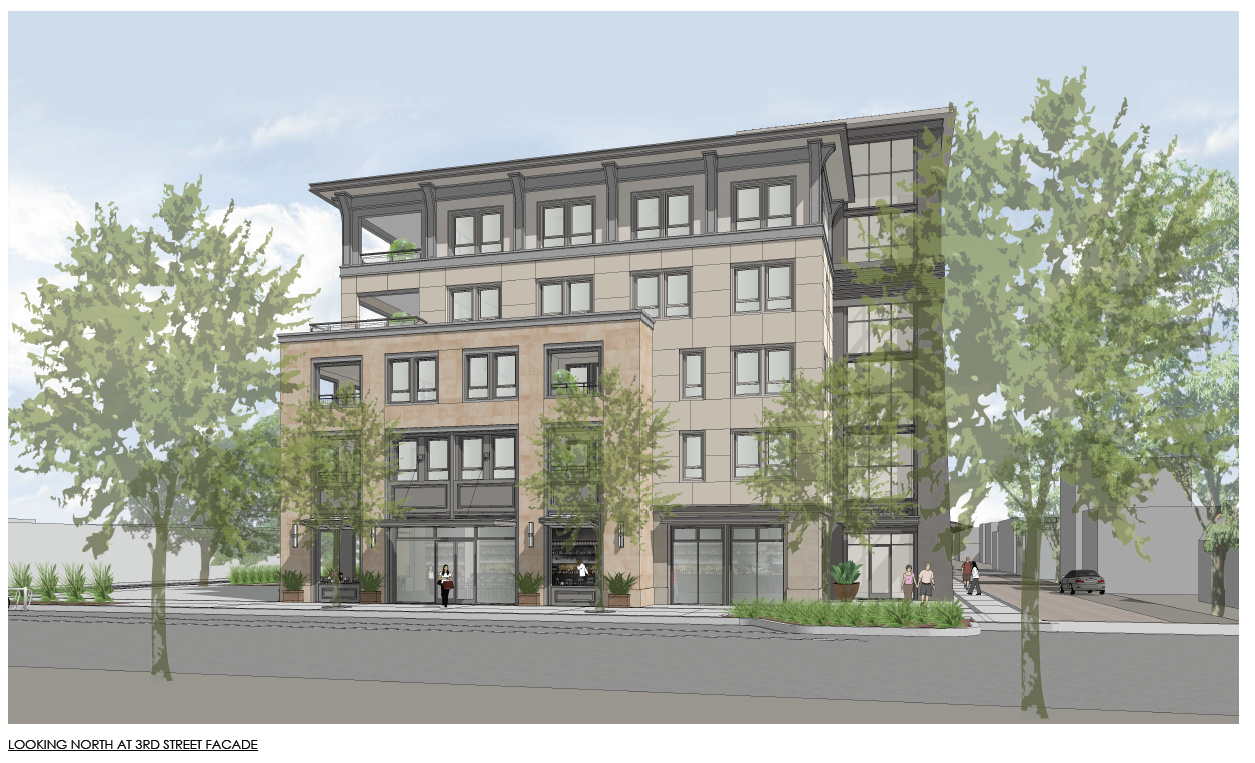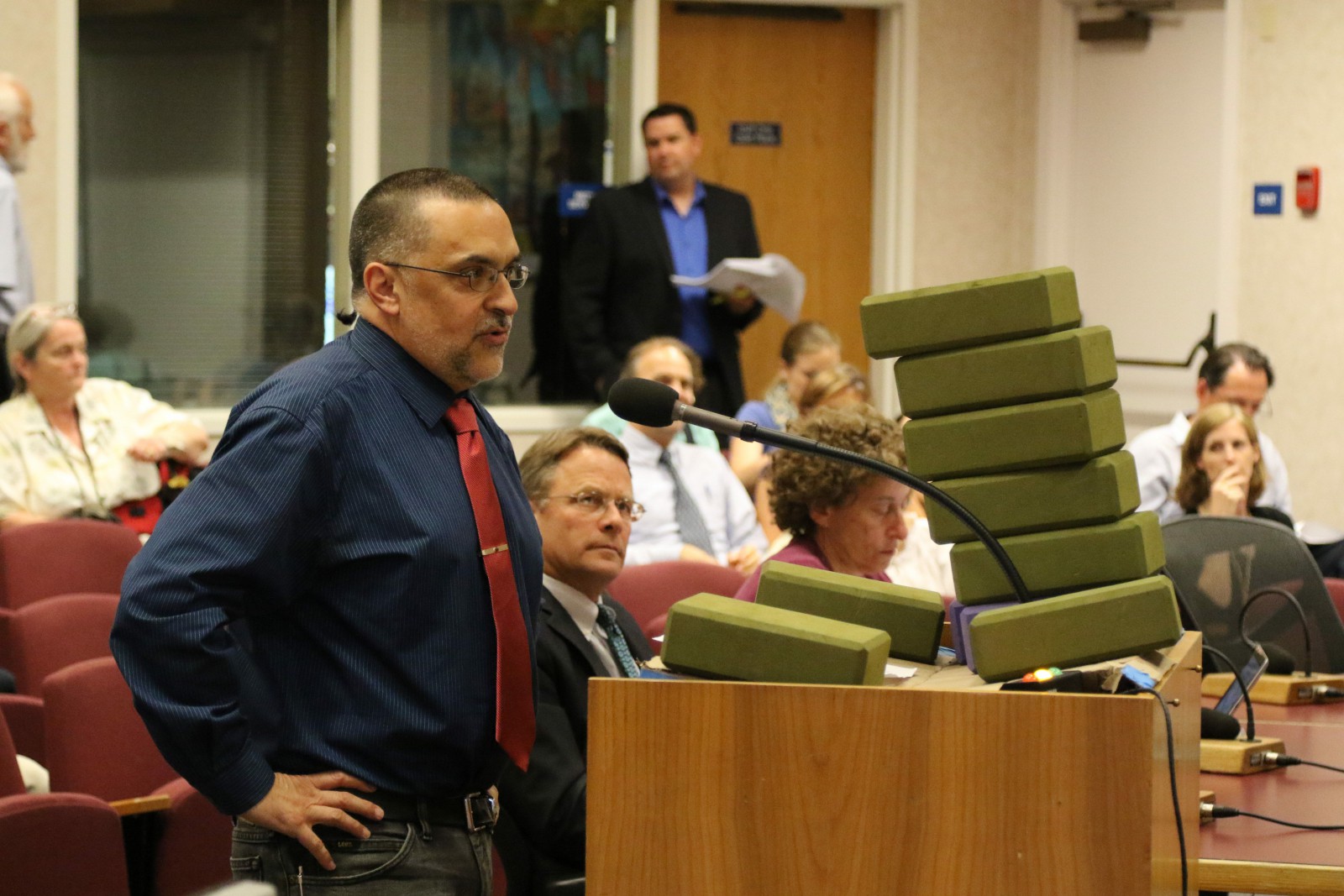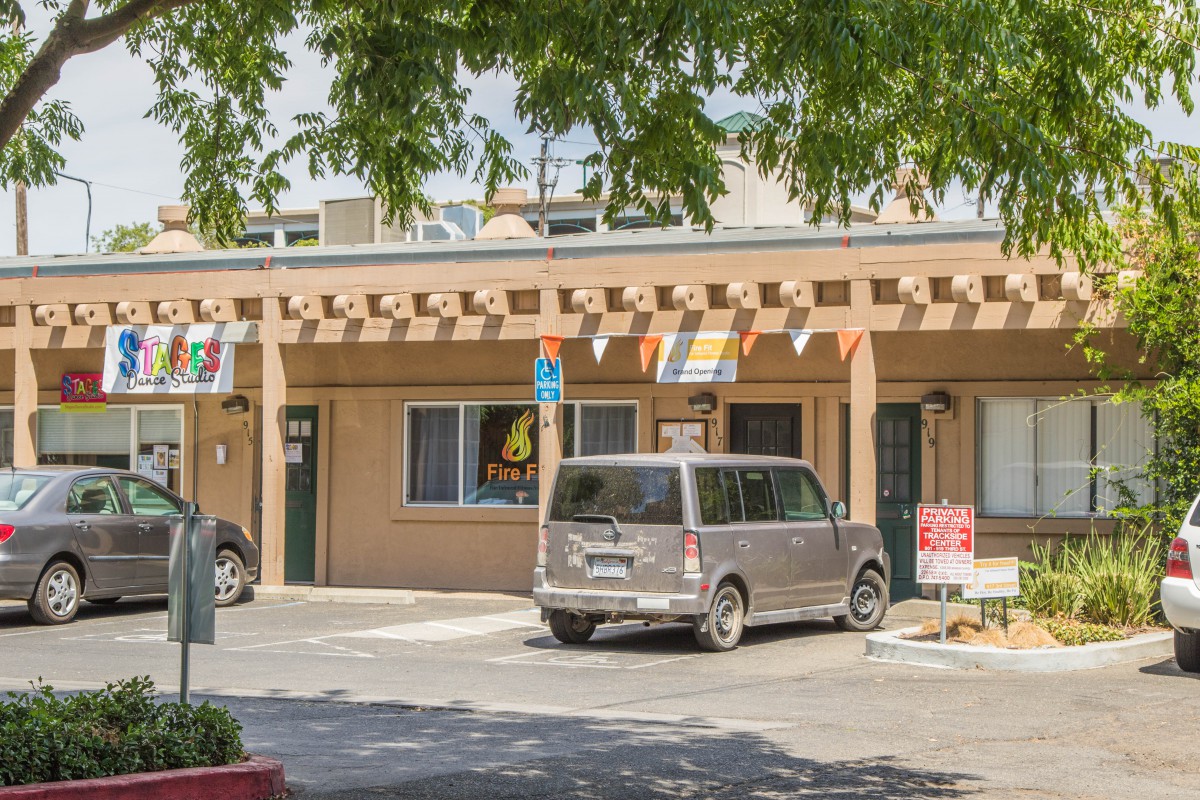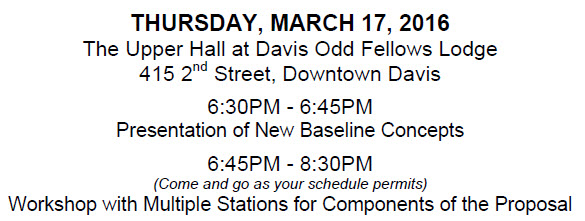

The ten months since a group of investors announced plans to redevelop a property along Third Street just to the east of the train tracks have not gone as smoothly as the development team had hoped. On Wednesday, in a press release, they acknowledged the need to create a new proposal and are inviting community members to a March 17 planning meeting in order to recommend changes.
In a statement they said, “In response to ten months of ongoing discussions with many community groups and citizens, public meetings and comments from the general public, the owners of Trackside Center, LLC have decided to host a public workshop to seek consensus on a new redevelopment proposal for an infill site at 901-919 Third Street (aka Trackside Center) in the Core Area of Davis.”
In May 2015, a proposal was submitted to the City of Davis for a new, mixed-use redevelopment of the property, which would have included 10,000 square feet of retail/commercial space on the ground floor with five floors of rental residential units above. They state, “The plans for the property have since gone back to the drafting table with all of the input received in the past ten months. Trackside Center’s Project Managers and new architect have endeavored to create the baseline components of a new proposal that address the comments expressed about the original May 2015 proposal.”
A mid-June meeting of the city council brought many concerns of the neighbors out into the open.

Located at the southwest corner of the city block bounded by 3rd/4th Streets and California Northern Railroad’s short-line railroad (RR) and I Street, the quarter acre property represents “one of the largest infill opportunities in the Core Area of Davis.”
It is currently an underutilized site, with two commercial buildings, each one story, that take up about half of the lot, and the other half is private parking.
However, for neighbors, they complained that they were not consulted on the designs which called for five and one-half stories that threatened sight-lines and created visual obstructions for the neighbors living in one- and two-story buildings.
Tia Will told the council that she is “absolutely delighted at the thought of an upgrade to these buildings which are very old, clearly past their prime, and needing development.”
However, she was critical of the project as designed. “The proposal is to put in a six-story building in an area in which the maximal height of residences is two stories and many of them are one story. I see this as a clear departure from the nature of the existing neighborhood.”
Neighbors have expressed concerns about parking. The developer last fall told the Vanguard that the plan called for 51 spaces of underground parking. They have been told by city staff that the project currently meets the need for the number of spaces that would be acceptable.

They also explained that this was not intended as student housing, and, while they cannot prevent students from living there, they will require the residents of the unit to pass a credit history themselves and have to qualify in order to live there.
The current design has the project at a market rate cost, with sizes ranging from 795 to 2000 square feet. There are only two at the maximum size. There are one to three bedrooms in the units.
Six of them are proposed to be less than 1000 square feet, another 16 are around 1200 to 1400 square feet. And there are sizes between 1400 and 2000 square feet.
One of the managing partners, Steve Greenfield, explained, “The philosophy is that yes, we feel the downtown needs to go up.” The specific height needs to play out, but they firmly believe that downtown needs to go up.
But the neighbors were insistent that the project violated the city’s guidelines and pushed for a two-story maximum.

Now, Trackside looks to go back to the drawing board.
The developers also announced a change in ownership, while the project remains “a crowd-funded endeavor of 40+ Davis residents.” There are reasons that have compelled individual investors to divest their shares in the company.
The developers announced on Wednesday, “Recently, several existing members increased their investment in the company by purchasing all of the shares owned by departing members. William & Amy Habicht and Stacie & Lucas Frerichs are no longer investors in the company.”
The developers note, “Recently, certain California Conflict of Interest regulations have been amended, affecting when public officials have conflicts arising from real property investments. It has been determined that an investment in this infill project could preclude Lucas Frerichs, a Davis City Council Member, from participating in many important discussions and decisions about the future of Downtown Davis. The former members remain supporters of infill redevelopment in Downtown Davis.”

According to the press release, at the workshop on March 17, “participants will have the opportunity to provide input on many components of the new proposal including building height, overall size and footprint of the building, number and type of residential units, amount and location of retail space, open space, accessibility, sustainability components and more.”
Guiding Principles for Redevelopment of Trackside Center. The owners of the project remain committed to their guiding principles for redevelopment of the site:
- Create a distinct sense of place that is aesthetically pleasing,
- Create a neighborhood/community gathering space,
- Authentic architecture and high-quality materials,
- Contextual to Downtown Davis and Old East Davis,
- Environmentally sustainable design,
- Urban sophistication with university town charm,
- Meets housing needs of current Davis residents,
- Modern commercial opportunities for local businesses,
- Flexible design to anticipate future technologies,
- Universal/accessible design

—David M. Greenwald reporting

Easy: three stories.
How do you know three stories pencils out?
Who cares? If they can’t pencil out at three stories they shouldn’t have bought the property. Should we let developers build as big and tall as they want in order to make sure they pencil out?
A good starting point is to comply with the M-U Zoning regulations.
It is better for the City’s evolution if the Developer pushes the boundaries of the zoning regulations, thus bringing in potentially new ideas that help the City prosper. Zoning documents are really backward looking in the sense that they are what the people could imagine or accept at that time. The world changes and the zoning decisions that seemed appropriate 10 years ago may no longer fit with the needs of the City. Just because a Developer presents an idea, however, doesn’t necessarily make it a good one, which is why we have a planning process that includes negotiations between the City and the Developer to create a project that is acceptable to both.
Mark and Frankly, the points you make about the backward looking nature of zoning regulations and their boundaries make sense in general rule because as a rule the broad fabric of zoning regulations only changes when a General Plan is updated. However, we all know that focused exceptions to the General Plan are allowed for a maximum of four times per year by State law. A multi-year, open, transparent, public-participation process took place in 2005 to establish a forward-looking standard for the Trackside parcel (as well as the Davis Ace Rock Yard parcel to the north of Trackside). “Fit with the needs of the City” was very much the central theme of that process, with the result being the movement of the specific parcels out of the Old East Davis Neighborhood Specific Plan, and into the specific M-U zone (Mixed Use).
Three stories [with the possibility of more than 3 if the building’s total Floor Area Ratio (FAR) does not exceed 2.0] is what the community believed was forward looking. So engaging Frankly’s statement, “All zoning regulations are subject to exception approval based on what is good for the community. The determination should be based on what is reasonable.” the question would appear to be how/why more than the allowed M-U 2.0 FAR and 3 (possibly 4) stories is good for the community and/or “reasonable”?
Matt – you are talking about something that happened a decade ago. The world changes, as do the needs of the City.
I understand your point Mark. The key is to have open, transparent, reliable, repeatable processes. Inclusion rather than exclusion. Do you see any reason why the current zoning revision application shouldn’t undergo the same public, due diligence process that looked at the city’s “needs” during the last zoning revision application for that parcel?
Accountability / Transparency / Trust
Matt – The point of the planning process is to evaluate projects in light of current needs and world realities. How transparent that process is, is completely within the control of the City (and not at all within mine).
Excellent point Mark. You and I are 100% in agreement on that.
All zoning regulations are subject to exception approval based on what is good for the community. The determination should be based on what is reasonable.
That’s the problem – right now we are zoning and planning by exception which makes the entire process underpredictable and frankly random.
Frankly has always been random. Its his nature.
Hey, I am consistently randomly consistent.
If ALL the development has to have some exception just to proceed, the Zoning is unreasonable. All I see is huge proposed developments, all exceeding common sense, with exaggerated predictions of City Benefits, which end up being the opposite.
Welcome to Davis.
M-U Zoning allows for 3 stories and open to higher stories.
It is a good project that has unfortunate impacts on the residential housing just adjacent. The parking structure is larger and doesn’t seem to impact people. I think that the difference is that there is a feeling of a buffer that this project lacks. If the project were placed on the other side of the railroad tracks, would it be such an issue? I don’t think Mike Harrington’s suggestion of 3 stories would make any difference. The neighbors would still be looking at a wall with windows overlooking their yard. So 3 stories, 5 stories, doesn’t matter.
Here is the key. If you live in or near the core area in a growing city, unless the city is growing outward, expect to have tall buildings next to you eventually.
The problem is you end up people who have been living there for decades having to adjust after the fact.
That is the point. It is their responsibility to get ready to adjust. The reality is clear. Denial is not an acceptable behavior that justifies empathy.
You might not build a house next to the airport… the airport might get built afterwards… but say the area grows and there is more flight traffic. You would not deserve empathy in criticism of the impacts from the increase in traffic because anyone with half a brain good see it in advance.
I have a three story building I built in 2002. It pencils out just fine. Even has a nice basement suite.
Trackside bought the land relatively cheap, valued for the zoning and what is there now, and then added five stories to the value. So heck yes, 3 stories pencils out.
DG: BTW, a really nice article. The photos are very helpful to understanding the situation.
It’s all about what fits … and 3 would fit fine.
The last I checked you didn’t have underground parking on your site
“I have a three story building I built in 2002. It pencils out just fine.”
What made sense to you 14 years ago has no bearing whatsoever on what will work for a different owner on a different parcel today.
Not if you have stated publicly that you intend to have this project fund your retirement.
Mike paid in lieu fees, because he didn’t want to provide the required parking on the property. Mike’s is a different type of building – not residential, so no multiple kitchens, bathrooms, multiple air conditioning/heating, parking, etc., so one can’t really compare the two projects.
“It’s all about what fits …,” says the man who opposed and organized a campaign against a one story modular building on the property next door to him that would have upgraded the STEAC Food Closet from a a couple of shacks.
What’s the definition of penciling out? Cover costs today? Cover cost in 10 years? 20 years? 30 years?
Cover costs plus 10% profit for investors? 50% profit? 100 % profit?
You think someone is going to invest money in a project only to cover costs? That’s a municipal standard. These guys are doing this to make money.
Yes indeed. They’re there to make money. How much money should they make? The bigger they build it the more they make. Should they open their books if penciling out and making a profit is first and foremost?
Are you willing to open your books to your neighbors when you decide to remodel your house? How much the Developer makes is really none of our business and the idea of ‘whether it pencils out for the Developer’ is frankly nonsense. The only consideration that we residents need to worry about is will the project pencil out for the City. If it doesn’t work for the Developer the project won’t be built. That is the risk the City takes when it asks for the bells and whistles demanded by certain constituents.
“The only consideration that we residents need to worry about is will the project pencil out for the City.”
I agree as long as the developer is staying within zoning and design guidelines then it is no one else’s business if it “pencil’s out” for them. If they are asking for exceptions ( or favors and concessions depending on how one looks at it) then it is a different matter. You are right that it is none of our business if it “pencils out” for them or not. But then they should not be complaining when a project that they are being denied because of these previously determined specifications is not approved. If they cannot make a project within those guidelines “pencil out” for them, then perhaps they should not be putting a project forward. After all, it is they that did the initial design, not the city, and certainly no the neighbors.